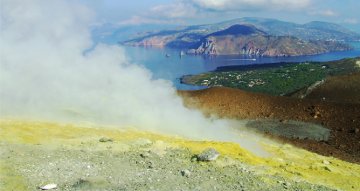
Sulfur
Sulfur General
| Name:Sulfur | Symbol:S |
| Type:Non-Metal, Chalcogen | Atomic weight:32.06 |
| Density @ 293 K:2.07 g/cm3 | Atomic volume: 15.5 cm3/mol |
|
Discovered:
Sulfur has been known since ancient times and is referred to in the Bible as brimstone. The name may have been derived from the Arabic 'sufra', meaning yellow. |
|
Sulfur States
| State (s, l, g):solid | |
| Melting point:388.4 K (115.2 °C) | Boiling point:717.9 K (444.7 °C) |
Sulfur Energies
| Specific heat capacity:0.71 J g-1 K-1 | Heat of atomization:279 kJ mol-1 |
| Heat of fusion:1.7175 kJ mol-1 | Heat of vaporization : 9.8 kJ mol-1 of S2 |
| 1st ionization energy:999.6 kJ mol-1 | 2nd ionization energy:2251 kJ mol-1 |
| 3rd ionization energy:3360.6 kJ mol-1 | Electron affinity:200.4144 kJ mol-1 |
Sulfur Oxidation & Electrons
| Shells:2,8,6 | Electron configuration:[Ne] 3s2 3p4 |
| Minimum oxidation number:-2 | Maximum oxidation number:6 |
| Min. common oxidation no.:-2 | Max. common oxidation no.:6 |
| Electronegativity (Pauling Scale):2.58 | Polarizability volume: 2.9 Å3 |
Sulfur Appearance & Characteristics
| Structure:S8 rings | Color: yellow |
| Hardness:2 mohs | |
|
Harmful effects:
Elemental sulfur is considered to be of low toxicity. Compounds such as carbon disulfide, hydrogen sulfide, and sulfur dioxide are toxic. For example, at 0.03 parts per million, we can smell hydrogen sulfide but it is regarded as safe for eight hours of exposure. At 4 ppm it may cause eye irritatation. At 20 ppm exposure for more than a minute causes severe injury to eye nerves. At 700 ppm breathing stops. Death will result if there is not a quick rescue. Permanent brain damage may result. (1) |
|
|
Characteristics:
Sulfur is a soft, pale yellow, odorless, brittle solid. It is insoluble in water, but soluble in carbon disulfide. It burns with a blue flame, oxidizing to sulfur dioxide. Uses: Sulfur's main commercial use is as a reactant in the production of sulfuric acid (H2SO4). Sulfuric acid is the industrialized world's number one bulk chemical, required in large quantities in lead-acid batteries for automotive use. |
|
Sulfur Reactions
| Reaction with air:vigorous, w/ht ⇒ SO2 | Reaction with 6 M HCl:none |
| Reaction with 15 M HNO3:vigorous, ⇒ H2SO4, NOx | Reaction with 6 M NaOH:none |
Sulfur Compounds
| Oxide(s):SO2, SO3 | Chloride(s):S2Cl2, SCl2 |
| Hydride(s):H2S (hydrogen sulfide) |
Sulfur Radius
| Atomic radius:100 pm | Ionic radius (1+ ion):pm |
| Ionic radius (2+ ion):pm | Ionic radius (3+ ion):pm |
| Ionic radius (2- ion):170 pm | Ionic radius (1- ion):pm |
Sulfur Conductivity
| Thermal conductivity: 0.205 W m-1 K-1 | Electrical conductivity:5.0 x 10-14 S cm-1 |
Sulfur Abundance & Isotopes
| Abundance earth's crust:350 parts per million by weight, 225 parts per million by moles | |
| Abundance solar system:400 parts per million by weight, 10 parts per million by moles | |
| Cost, pure:$50 per 100g | |
| Cost, bulk:$ per 100g | |
|
Source:
Sulfur deposits are found naturally in areas around hot springs and in volcanic regions. It is also widely found in nature as iron pyrites (iron sulfide), galena (lead sulfide), gypsum (calcium sulfate), Epsom salts (magnesium sulfate) and many other minerals. Sulfur is recovered commercially from underground deposits using the Frasch Process - superheated water and steam are pumped underground, where they |
|
|
Isotopes:
Sulfur has 18 isotopes whose half-lives are known, with mass numbers 27 to 45. Of these, four are stable: 32S, 33S, 34S, and 36S. 95% of naturally occurring sulfur is in the form of 32S. |
|
Sulfur Other
|
Other:
|
|
Prev: Phosphorus Next: Chlorine |